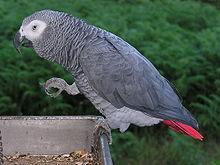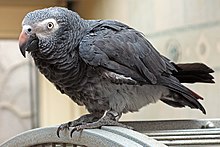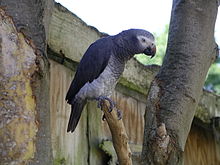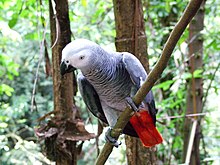
Amazon parrots are parrots in the genus Amazona. They are medium-sized, short-tailed parrots native to the Americas, with their range extending from South America to Mexico and the Caribbean. Amazona is one of the 92 genera of parrots that make up the order Psittaciformes and is in the family Psittacidae, one of three families of true parrots. It contains about thirty species. Most amazons are predominantly green, with accenting colors that depend on the species, and they can be quite vivid. They feed primarily on seeds, nuts, and fruits, supplemented by leafy matter.

The salmon-crested cockatoo, also known as the Moluccan cockatoo, is a cockatoo endemic to the Seram archipelago in eastern Indonesia. At a height of up to 46–52 centimetres (1.51–1.71 ft) and weight of up to 850 grams (1.87 lb), it is among the largest of the white cockatoos. The female is slightly smaller than the male on average. It has white-pink feathers with a definite peachy glow, a slight yellow on the underwing and underside of the tail feathers and a large retractable recumbent crest which it raises when threatened, revealing hitherto concealed bright red-orange plumes to frighten potential attackers. It may also be raised in excitement or in other 'emotional' displays. Some describe the crest as "flamingo-colored". It also has one of the louder calls in the parrot world and in captivity is a capable mimic.

The Senegal parrot is a parrot which is a resident breeder across a wide range of west Africa. It makes migrations within west Africa, according to the availability of the fruit, seeds and blossoms which make up its diet. It is considered a farm pest in Africa, often feeding on maize or millet. It is popular in aviculture.

The Alexandrine parakeet, also known as the Alexandrine parrot, is a medium-sized parrot in the genus Psittacula of the family Psittaculidae, native to South Asia and Southeast Asia. It is named after Alexander the Great, who transported numerous birds from Punjab to various European and Mediterranean countries and regions, where they were prized by the royalty, nobility and warlords.

The scarlet macaw is a large yellow, red and blue Neotropical parrot native to humid evergreen forests of the Americas. Its range extends from southeastern Mexico to Peru, Ecuador, Colombia, Bolivia, Venezuela and Brazil in lowlands of 500 m (1,600 ft) up to 1,000 m (3,300 ft), the Caribbean island of Trinidad, as well as the Pacific island of Coiba. Formerly, the northern extent of its range included southern Tamaulipas. In some areas, it has suffered local extinction because of habitat destruction, or capture for the parrot trade, but in other areas, it remains fairly common. It is the national bird of Honduras. Like its relative the blue-and-yellow macaw, the scarlet macaw is a popular bird in aviculture as a result of its striking plumage.

Feather-plucking, sometimes termed feather-picking, feather damaging behaviour or pterotillomania, is a maladaptive, behavioural disorder commonly seen in captive birds that chew, bite or pluck their own feathers with their beak, resulting in damage to the feathers and occasionally the skin. It is especially common among parrots, with an estimated 10% of captive parrots exhibiting the disorder. The areas of the body that are mainly pecked or plucked are the more accessible regions such as the neck, chest, flank, inner thigh and ventral wing area. Contour and down feathers are generally identified as the main target, although in some cases, tail and flight feathers are affected. Although feather-plucking shares characteristics with feather pecking commonly seen in commercial poultry, the two behaviours are currently considered to be distinct as in the latter, the birds peck at and pull out the feathers of other individuals.

The black-billed amazon is a parrot endemic to Jamaica. Sometimes called the black-billed parrot, this amazon parrot is mostly green with small patches of red on the wing and sometimes flecked on the head. Its bill makes it easy to separate from most other amazons, including the yellow-billed amazon, which also lives in Jamaica. It is the smallest Amazona parrot at 25 cm (10 in).

The red-shouldered macaw is a small green South American parrot, a member of a large group of Neotropical parrots called macaws. The species is named for the red coverts on its wings. It is the smallest macaw, being 30–35 cm (12–14 in) in length - similar in size to the Aratinga parakeets. It is native to the tropical lowlands, savannah, and swamplands of Brazil, the Guianas, Bolivia, Venezuela, and far south-eastern Peru. It has two distinct subspecies, the noble macaw and the Hahn's macaw, and a possible poorly distinct third subspecies that has longer wings, but is otherwise similar to the noble macaw. The Hahn's subspecies is named for German zoologist Carl-Wilhelm Hahn, who in 1834 began compiling Ornithologischer Atlas oder naturgetreue Abbildung und Beschreibung der aussereuropäischen Vögel.

The difficulty of defining or measuring intelligence in non-human animals makes the subject difficult to study scientifically in birds. In general, birds have relatively large brains compared to their head size. The visual and auditory senses are well developed in most species, though the tactile and olfactory senses are well realized only in a few groups. Birds communicate using visual signals as well as through the use of calls and song. The testing of intelligence in birds is therefore usually based on studying responses to sensory stimuli.

The rosy-faced lovebird, also known as the rosy-collared or peach-faced lovebird, is a species of lovebird native to arid regions in southwestern Africa such as the Namib Desert. Loud and constant chirpers, these birds are very social animals and often congregate in small groups in the wild. They eat throughout the day and take frequent baths. Coloration can vary widely among populations. Plumage is identical in males and females. Lovebirds are renowned for their sleep position in which they sit side-by-side and turn their faces in towards each other. Also, females are well noted to tear raw materials into long strips, "twisty-tie" them onto their backs, and fly substantial distances back to make a nest. These birds are common in the pet industry.

The red-lored amazon or red-lored parrot is a species of amazon parrot, native to tropical regions of the Americas, from eastern Mexico south to Ecuador where it occurs in humid evergreen to semi-deciduous forests up to 1,100 m altitude. It is absent from the Pacific side of Central America north of Costa Rica. Not originally known from El Salvador, a pair - perhaps escaped from captivity - nested successfully in 1995 and 1996 in the outskirts of San Salvador and the species might expand its range permanently into that country in the future. This species has also established feral populations in several California cities.

The Mascarene parrot or mascarin is an extinct species of parrot that was endemic to the Mascarene island of Réunion in the western Indian Ocean. The taxonomic relationships of this species have been subject to debate; it has historically been grouped with either the Psittaculini parrots or the vasa parrots, with the latest genetic study favouring the former group.

The Cape parrot or Levaillant's parrot is a large, temperate forest dwelling parrot of the genus Poicephalus endemic to South Africa. It was formerly grouped as a subspecies along with the savanna-dwelling brown-necked parrot and grey-headed parrot, but is now considered a distinct species.
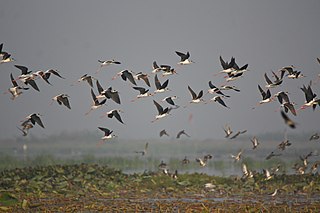
A flock is a gathering of individual birds to forage or travel collectively. Avian flocks are typically associated with migration. Flocking also offers foraging benefits and protection from predators, although flocking can have costs for individual members.
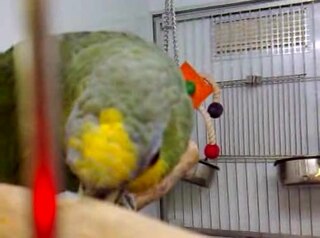
Talking birds are birds that can mimic the speech of humans. There is debate within the scientific community over whether some talking parrots also have some cognitive understanding of the language. Birds have varying degrees of talking ability: some, like the corvids, are able to mimic only a few words and phrases, while some budgerigars have been observed to have a vocabulary of almost 2,000 words. The hill myna, a common pet, is well known for its talking ability and its relative, the European starling, is also adept at mimicry. Wild cockatoos in Australia have been reported to have learned human speech by cultural transmission from ex-captive birds that have integrated into the flock.
Vocal learning is the ability to modify acoustic and syntactic sounds, acquire new sounds via imitation, and produce vocalizations. "Vocalizations" in this case refers only to sounds generated by the vocal organ as opposed to by the lips, teeth, and tongue, which require substantially less motor control. A rare trait, vocal learning is a critical substrate for spoken language and has only been detected in eight animal groups despite the wide array of vocalizing species; these include humans, bats, cetaceans, pinnipeds, elephants, and three distantly related bird groups including songbirds, parrots, and hummingbirds. Vocal learning is distinct from auditory learning, or the ability to form memories of sounds heard, a relatively common trait which is present in all vertebrates tested. For example, dogs can be trained to understand the word "sit" even though the human word is not in its innate auditory repertoire. However, the dog cannot imitate and produce the word "sit" itself as vocal learners can.

Parrots (Psittaciformes), also known as psittacines, are birds with a strong curved beak, upright stance, and clawed feet. They are conformed by four families that contain roughly 410 species in 101 genera, found mostly in tropical and subtropical regions. The four families are the Psittaculidae, Psittacidae, Cacatuoidea (cockatoos), and Strigopidae. One-third of all parrot species are threatened by extinction, with a higher aggregate extinction risk than any other comparable bird group. Parrots have a generally pantropical distribution with several species inhabiting temperate regions as well. The greatest diversity of parrots is in South America and Australasia.
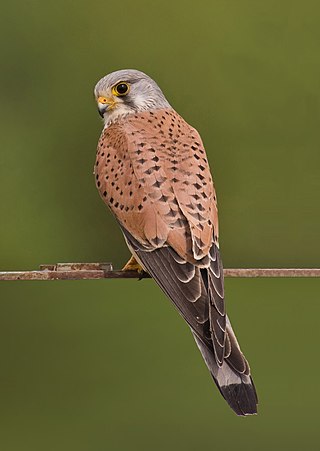
Eufalconimorphae is a proposed clade of birds, consisting of passerines, parrots, falcons, caracaras, and forest falcons. It has whole-genome DNA support. Eufalconimorphae birds are characterized by their strong and hooked beaks, sharp talons, and powerful wings. They have excellent eyesight, which allows them to spot their prey from great distances. The Eufalconimorphae is noted to produce aerodynamic force during the upstroke of flight to help create a vertical flight pattern.

The Timneh parrot, also known as the Timneh grey parrot or Timneh African grey parrot, is a West African parrot. Formerly classified as a subspecies of the grey parrot Psittacus erithacus timneh, it is now considered a full species Psittacus timneh. In aviculture, it is often referred to by the initials TAG and is commonly kept as a companion parrot.

The grey parrot, also known as the Congo grey parrot, Congo African grey parrot or African grey parrot, is an Old World parrot in the family Psittacidae. The Timneh parrot (Psittacus timneh) once was identified as a subspecies of the grey parrot, but has since been elevated to a full species.
